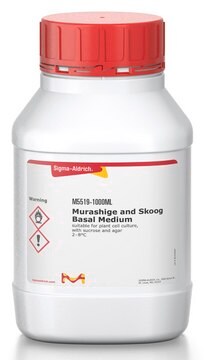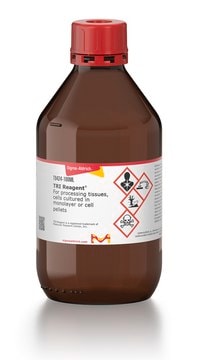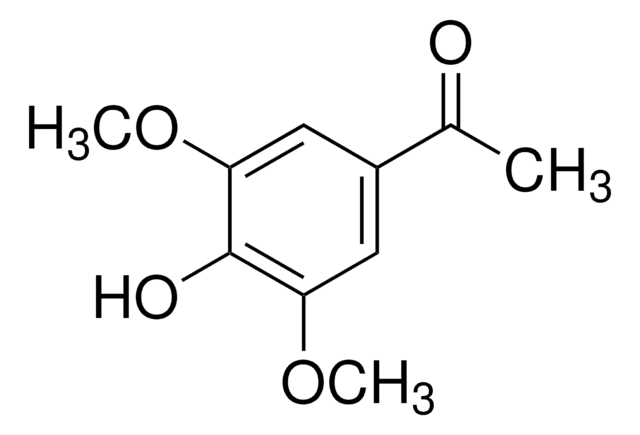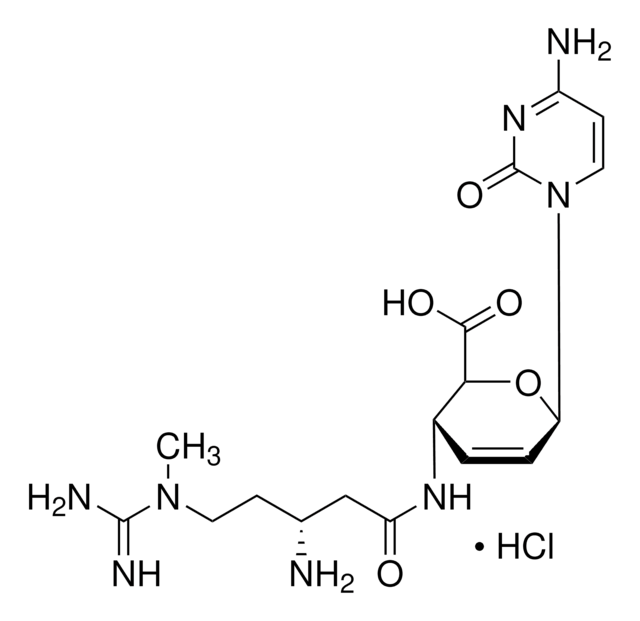H9773
Higromicina B from Streptomyces hygroscopicus
lyophilized powder, suitable for plant cell culture, BioReagent
Sinónimos:
Hygromycin
About This Item
Productos recomendados
Nombre del producto
Higromicina B from Streptomyces hygroscopicus, suitable for plant cell culture, BioReagent, ≥60% (HPLC), lyophilized powder
origen biológico
Streptomyces hygroscopicus
Nivel de calidad
Línea del producto
BioReagent
Formulario
lyophilized powder
purificado por
ion-exchange chromatography
concentración
≥60% (HPLC)
técnicas
cell culture | plant: suitable
color
faintly brown to brown
white to beige
(1) 7.1, (2) 8.8
solubilidad
H2O: soluble 50 mg/mL
ethanol: soluble
methanol: soluble
espectro de actividad antibiótica
fungi
aplicaciones
agriculture
Modo de acción
protein synthesis | interferes
temp. de almacenamiento
2-8°C
cadena SMILES
CN[C@H]1C[C@@H](N)[C@H](O)[C@@H](O[C@@H]2O[C@H](CO)[C@H](O)[C@@H]3O[C@]4(O[C@H]([C@H](N)CO)[C@H](O)[C@H](O)[C@H]4O)O[C@H]23)[C@@H]1O
InChI
1S/C20H37N3O13/c1-23-7-2-5(21)9(26)15(10(7)27)33-19-17-16(11(28)8(4-25)32-19)35-20(36-17)18(31)13(30)12(29)14(34-20)6(22)3-24/h5-19,23-31H,2-4,21-22H2,1H3/t5-,6-,7+,8-,9+,10-,11+,12-,13+,14-,15-,16+,17+,18-,19+,20+/m1/s1
Clave InChI
GRRNUXAQVGOGFE-XKIAHZFYSA-N
¿Está buscando productos similares? Visita Guía de comparación de productos
Descripción general
Aplicación
Hygromycin B from Streptomyces hygroscopicus is used for gene cloning and ectopic expression. It is also used in MS medium for the in vitro screening of transgenic plants.
Acciones bioquímicas o fisiológicas
Espectro antimicrobiano: La higromicina B actúa contra bacterias, hongos y células eucariotas superiores.
Precaución
Nota de preparación
Palabra de señalización
Danger
Frases de peligro
Consejos de prudencia
Clasificaciones de peligro
Acute Tox. 1 Inhalation - Acute Tox. 2 Dermal - Acute Tox. 2 Oral
Código de clase de almacenamiento
6.1A - Combustible acute toxic Cat. 1 and 2 / very toxic hazardous materials
Clase de riesgo para el agua (WGK)
WGK 3
Punto de inflamabilidad (°F)
Not applicable
Punto de inflamabilidad (°C)
Not applicable
Elija entre una de las versiones más recientes:
¿Ya tiene este producto?
Encuentre la documentación para los productos que ha comprado recientemente en la Biblioteca de documentos.
Los clientes también vieron
Artículos
Prevent fungal, yeast, and mold contamination in cell cultures. Discover the best antifungal agent for your cultures with the extensive Sigma® antifungal collection.
Protein synthesis is a complex, multi-step process involving many enzymes as well as conformational alignment. However, the majority of antibiotics that block bacterial protein synthesis interfere with the processes at the 30S subunit or 50S subunit of the 70S bacterial ribosome.
Antibiotic kill curve is a dose response experiment in which mammalian cells are subjected to increasing amounts of selection antibiotic
Nuestro equipo de científicos tiene experiencia en todas las áreas de investigación: Ciencias de la vida, Ciencia de los materiales, Síntesis química, Cromatografía, Analítica y muchas otras.
Póngase en contacto con el Servicio técnico











